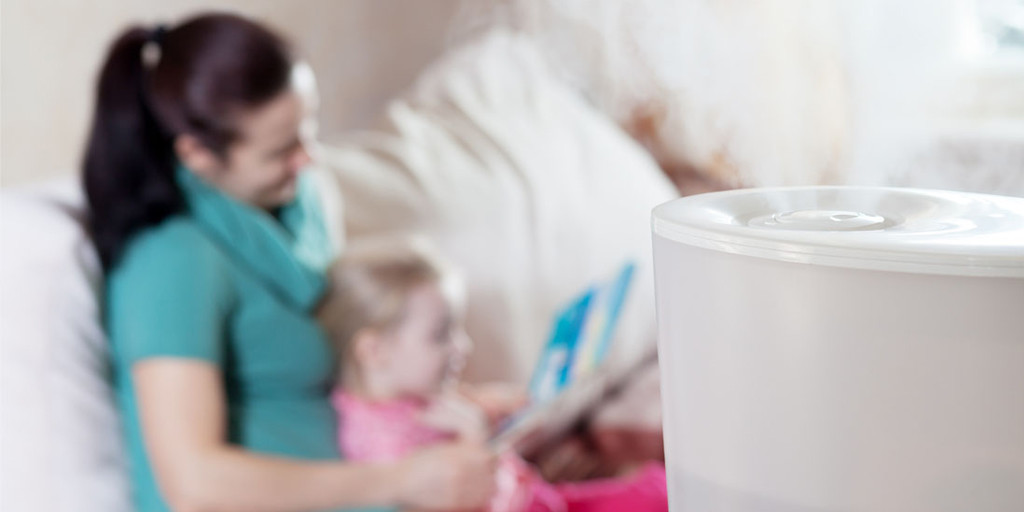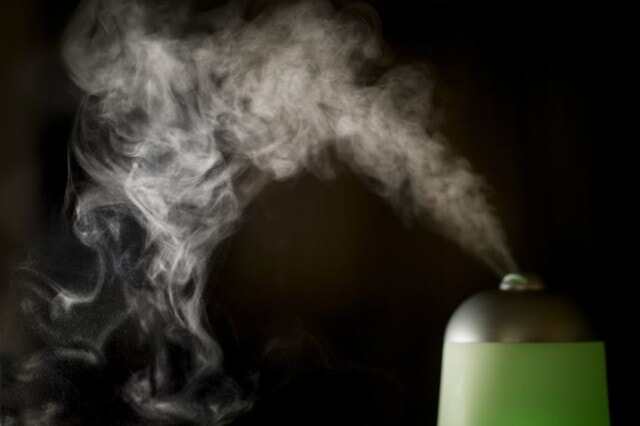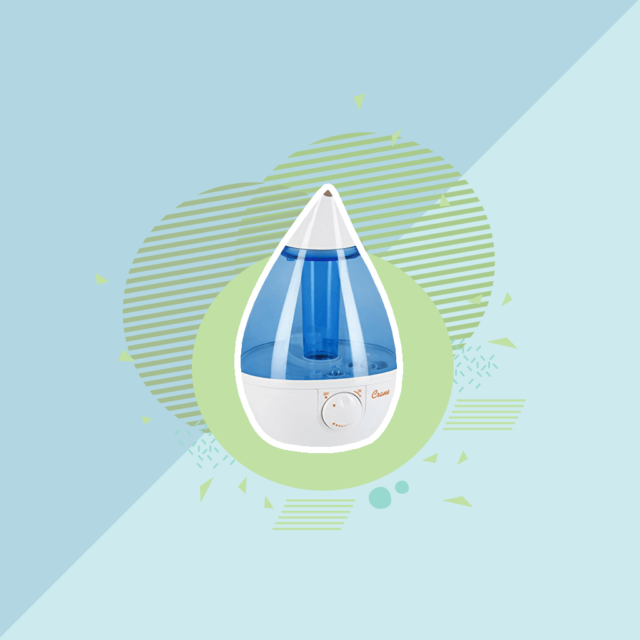What Does a Humidifier Do?
If seasonal allergies often spoil your summer, or you suffer from dry lips and itchy eyes in the dead of winter, what can you do to relieve your suffering? You might find help in the form of a humidifier.
What does a humidifier do? Put simply, it adds moisture to the air, which can ease sinus problems and may even make it easier to sleep at night. The American Academy of Allergy, Asthma and Immunology (AAAAI) recommends home air humidity of between 40 to 50 percent, a figure backed up by the Environmental Protection Agency. The AAAI recommends a humidifier particularly if you suffer from allergic rhinitis, (the generic name given to the condition caused by harmless substances in our air). The AAAI also estimates that 8 percent of American adults suffer from hay-fever; that’s just over 26 million people who could benefit from a humidifier.
So, do you need a humidifier? Are you always sneezing, rubbing itchy eyes and finding it hard to breathe at certain times of the year? Changing seasons bring with them changes in humidity, particularly during the winter season. There are also external factors that could affect the air in our homes. If you live in area with heavy industry, it could significantly increase the chances of an allergic reaction. On the flip side, living in the countryside could be just as harmful, because of pollen. Regardless, when we wake up with chapped lips, dry skin, irritated eyes, blocked nasal passages, or irritated sinus passages, we know we need to find solutions or live in misery.
This article explains what humidifiers do and the key role that they can play in optimizing the humidity in your living space. Then we’ll break down the differences between the most common types of humidifiers and then weigh the pros and cons of the appliance so that you can find the model that works best for you.
How is Humidity Measured?
Scientists use the ratio of the mass of water vapor to the volume of air to calculate absolute humidity. And it’s worth noting that there is more than one type of humidity:
- Absolute Humidity: The measure of water vapor (moisture) in the air, regardless of temperature, and is expressed as grams of moisture per cubic meter of air (g/m3). An example would be: The maximum absolute humidity of warm air at 30°C/86°F is approximately 30g of water vapor, or 30g/m3.
- Relative Humidity: The measure of water vapor in the air, but relative to the temperature, and is expressed as a percentage.
If the relative humidities were equal in warm and cold air, then the absolute humidity would be higher in the colder air, because warm air naturally holds more humidity.
What Affects the Humidity Levels?
The changing seasons bring changes in the humidity levels of homes. In winter, for example, doors and windows remain shut to keep out the chill, and the heating is on full blast. This means dry indoor air, which in turn can mean the onset of all the symptoms we mentioned previously. Asthma, for instance, can increase when there is either no moisture in the air or too much. At the same time, however, you don’t want to add too much moisture to the air. Dust mites love moist conditions, so overly humidified air might increase your chances of having an allergic reaction. It follows that getting the humidity right is crucial for the potential health benefits; get it wrong, and the humidifier could do more harm than good.
Different Types of Humidifiers
While humidifiers all work to add moisture to the air to create optimum humidity levels, they don’t all work the same way. Advances in technology in recent years have results in different styles with various features that are important to keep in mind. Let’s start with a basic chart outlining these various styles, and then we take a closer look at each one.
| Types of Humidifiers | |||
|---|---|---|---|
| Cool Mist | Warm Mist | ||
| Evaporative | Impeller | Steam | Vaporizer |
| Ultrasonic | |||
Cool Mist Humidifiers
Cool mist humidifiers cover a greater area when dispersing the cool mist. This means that the need to purchase more humidifiers is reduced. Cool mist humidifiers also use less electricity and are a safer alternative because there isn’t a heating element to the process of dispersing the mist.
There are downsides to a cool mist humidifier. For one, the unit can be noisier than the warm mist models, because the cool mist variety uses a fan to operate. At night this whirring fan can be a distraction when you’re trying to get a full night’s sleep. In addition, cool mist humidifiers tend to have more moving parts so the tendency for something to go wrong increases.
Evaporative
Evaporative humidifiers use a fan and a wick filter to disperse the moisture. The water in the reservoir is drawn using a paper or cloth sheet, and blown by the fan towards the wick filter. The wick allows the water to evaporate, releasing moisture into the air, and the air reduces in temperature. The wick filter also catches impurities, improving the quality of the air in the humidified area. The wick filter will need replacement (consider replacing every second month); however, it will need to be cleaned and thoroughly dried between replacements.
Impeller
Impeller humidifiers work with a rotating disc that sends water from the reservoir through a diffuser. The water is then broken down to smaller drops and emitted into the atmosphere as droplets. One of the advantages of this humidifier is that it is one of the cleanest ways to humidify the air, and it can also cover more significant areas. These models can be noisy, though, and without frequent cleaning/replacement of the filter, bacteria can grow.
Warm Mist Humidifiers
Warm mist humidifiers can reduce the impurities in the water reservoir because the water is boiled, which kills all the harmful bacteria. They also negate the need for a filter, which could reduce costs, and cleaning time. Finally, because the water is heated, the temperature in the humidified area feels warmer, so if you have a cold, you’ll feel the benefits of a warm mist humidifier immediately.
The warm mist humidifier can be dangerous to young children, because the water in the reservoir is boiling. The other downside is the smaller area that the humidifier emits vapor. Cool mist humidifiers are better at covering larger areas.
Just like their cool mist counterparts, warm mist humidifiers also come in two types:
Steam
Steam humidifiers excel at killing bacteria. Because the water is heated, it retains more of the minerals in the water so you don’t breathe them in. It also operates without the need to replace the filters, so that could be a significant saving on the running costs. Steam humidifiers also need less cleaning due to the heated water element. It is also quieter than a cool mist humidifier as it doesn’t need a fan to operate, and they also warm the air slightly, which can be a perk in cooler climates. Steam humidifiers can be expensive to run, though, because of the heating element. They also disperse moisture over a smaller area, so the need for more humidifiers increases if you want more coverage.
Vaporizer
Similar to the steam humidifier, the vaporizer heats the water reservoir to boiling point using electrodes then emits that moisture into the air. Vaporizers are associated with the health benefits for those who suffer breathing difficulties, like asthma, or COPD. Vaporizers work well with medicinal inhalants, such as plant extracts, like menthol and herbs, making them great for easing coughs and colds. Moreover, there is less mold or bacteria build-up because, like the steam humidifier, the water is boiled. Vaporizers are not recommended for homes with young children as the water reservoir reaches boiling point, so hazards are more common.
Ultrasonic Humidifiers
Ultrasonic humidifiers can be both cool and warm mist. It’s the quietest of the models in the market as it operates via sound waves, so it’s virtually silent. The sound waves vibrate on a metal or ceramic diaphragm, creating tiny droplets of water, released into the air as a fine mist. They are easily portable, cheap to run, and for their size, it can produce an impressive amount of vapor. Furthermore, when it comes to cleaning, they are the least likely to cause bacteria growth.
Ultrasonic Cool Mist
Steam humidifiers excel at killing bacteria. Because the water is heated, it retains more of the minerals in the water so you don’t breathe them in. It also operates without the need to replace the filters, so that could be a significant saving on the running costs. Steam humidifiers also need less cleaning due to the heated water element. It is also quieter than a cool mist humidifier as it doesn’t need a fan to operate, and they also warm the air slightly, which can be a perk in cooler climates. Steam humidifiers can be expensive to run, though, because of the heating element. They also disperse moisture over a smaller area, so the need for more humidifiers increases if you want more coverage.
Ultrasonic Warm Mist
Steam humidifiers excel at killing bacteria. Because the water is heated, it retains more of the minerals in the water so you don’t breathe them in. It also operates without the need to replace the filters, so that could be a significant saving on the running costs. Steam humidifiers also need less cleaning due to the heated water element. It is also quieter than a cool mist humidifier as it doesn’t need a fan to operate, and they also warm the air slightly, which can be a perk in cooler climates. Steam humidifiers can be expensive to run, though, because of the heating element. They also disperse moisture over a smaller area, so the need for more humidifiers increases if you want more coverage.
Humidifier Benefits
There are so many potential benefits to bringing a humidifier into your living space, but let’s highlight some of the key ones here:
Allergy Relief: Regulating the moisture in the air can bring relief to hay-fever and rhinitis caused by airborne allergens can be unbearable for some sufferers.
Dry Eyes and Skin: Adding moisture helps with itchy eyes, chapped lips, and healthier skin brought on by dry winter air.
Home Warmth: Warm mist humidifier can raise the room temperature slightly, taking the chill out of a cool winter night.
Great for Plants: With moisture in the air, plants will feel healthier.
Wooden Furniture Preservation: Wood dries in the wrong atmospheric conditions, but humidity can prolong the life of wooden furniture.
Static Prevention: Static builds when the air is drier. Adding moisture could prevent potential situations like sparks occurring.
Colds and Flu Relief: Increased humidity can help you decongest blocked nasal passages and, if you add medicinal inhalants like menthol extract, it will leave you feeling able to breathe more comfortably, especially at night.
Disadvantages of a Humidifier
Now that we’ve laid out the perks of adding a humidifier to your home, it is important that we also note the potential pitfalls. Let’s review some of the problems that can come with use of the appliance:
Bacteria Growth: If not maintained and cleaned properly, humidifiers can become harbingers of bacteria and mold. These mold spore can cause breathing difficulties, so it is vital that your humidifier is kept clean in line with the manufacturer’s instructions so that the benefits will be felt for years to come.
High Humidity Levels: As we said earlier, the recommended levels of humidity in our homes should be roughly 40 to 50 percent. Increase that level, however, and the humidifier works against us as it makes the air harder to breathe and can cause some of the side effects that may have been the reason why you bought the unit in the first place.
White Dust: Tap water is full of minerals, the presence of which manifests itself as white dust in your home. This dust can cause breathing and lung problems. If possible, fill humidifiers with distilled water, to reduce the risk of harmful minerals and bacteria entering the air. It also helps prolong the life of your filter, and means the humidifier doesn’t need such a deep clean.
Final Thoughts
This article has hopefully helped bring our readers up to speed on the importance of humidifiers and the various types available in the market today. Before you jump into a purchase, you should consider your own needs first. For example, do you have small children? If so, it would be worth looking at a cool mist variety for safety reasons. How big is the space that you want to humidify? If you want a greater coverage, think about the cool mist variety again. They have a farther reach than the warm mist humidifiers. If you’re in the market for something silent, the ultrasonic model is the best choice. Whichever meets your needs, you can be rest assured that with proper maintenance, your humidifier will help you breathe a bit easier in your home for years to come.




